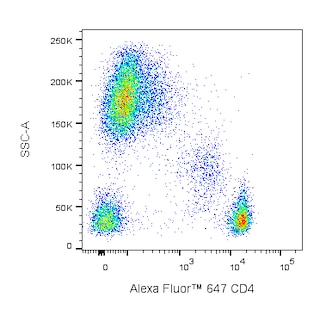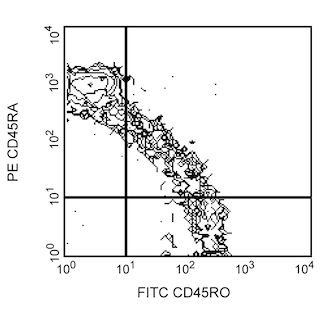Old Browser
This page has been recently translated and is available in French now.
Looks like you're visiting us from {countryName}.
Would you like to stay on the current country site or be switched to your country?






Flow cytometric analysis of CCR7 (CD197) on human peripheral blood lymphocytes. Whole blood was stained with Alexa Fluor®647 Mouse Anti-Human CD4 (clone RPA-T4, Cat. No. 557707), PE Mouse Anti-Human CD45RA (clone HI100, Cat. No. 555489 or 561883), and either BD Horizon™ BV421 Mouse IgG1, κ Isotype Control (Cat. No. 562438, Left Plot) or BD Horizon™ BV421 Mouse Anti-Human CCR7 (CD197) (Cat. No. 566743 or 566744, Right Plot). The erythrocytes were lysed with BD PharmLyse™ Lysing Buffer (Cat. No. 555899). Two-color flow cytometric contour plots showing the correlated patterns of CD45RA versus CCR7 (CD197) [or Ig isotype control] staining were derived from CD4-positive T cell gated events with the forward and side light-scatter characteristics of viable lymphocytes. Flow cytometry and data analysis were performed using a BD LSRFortessa™ Cell Analyzer System and FlowJo™ software. Data shown on this Technical Data Sheet are not lot specific.

Immunohistofluorescent staining of CCR7 (CD197) in human tonsil. The section of acetone-fixed frozen tissue was stained with BD Horizon™ BV421 Mouse Anti-Human CCR7 (CD197) (Cat. No. 566743 or 566744, pseudocolored green), and cell nuclei were counterstained with DRAQ5™ (Cat. No. 564902 or 564903, pseudocolored red). The CCR7 (CD197) staining identifies T lymphocytes among the lymphoid follicles. Photography was performed on a standard epifluorescence microscope. Original magnification, 20×.


BD Horizon™ BV421 Mouse Anti-Human CCR7 (CD197)

BD Horizon™ BV421 Mouse Anti-Human CCR7 (CD197)

Regulatory Status Legend
Any use of products other than the permitted use without the express written authorization of Becton, Dickinson and Company is strictly prohibited.
Preparation And Storage
Recommended Assay Procedures
BD™ CompBeads can be used as surrogates to assess fluorescence spillover (Compensation). When fluorochrome conjugated antibodies are bound to CompBeads, they have spectral properties very similar to cells. However, for some fluorochromes there can be small differences in spectral emissions compared to cells, resulting in spillover values that differ when compared to biological controls. It is strongly recommended that when using a reagent for the first time, users compare the spillover on cells and CompBead to ensure that BD Comp beads are appropriate for your specific cellular application.
For optimal and reproducible results, BD Horizon Brilliant Stain Buffer should be used anytime two or more BD Horizon Brilliant dyes are used in the same experiment. Fluorescent dye interactions may cause staining artifacts which may affect data interpretation. The BD Horizon Brilliant Stain Buffer was designed to minimize these interactions. More information can be found in the Technical Data Sheet of the BD Horizon Brilliant Stain Buffer (Cat. No. 563794/566349) or the BD Horizon Brilliant Stain Buffer Plus (Cat. No. 566385).
Product Notices
- This reagent has been pre-diluted for use at the recommended Volume per Test. We typically use 1 × 10^6 cells in a 100-µl experimental sample (a test).
- An isotype control should be used at the same concentration as the antibody of interest.
- Source of all serum proteins is from USDA inspected abattoirs located in the United States.
- Caution: Sodium azide yields highly toxic hydrazoic acid under acidic conditions. Dilute azide compounds in running water before discarding to avoid accumulation of potentially explosive deposits in plumbing.
- For fluorochrome spectra and suitable instrument settings, please refer to our Multicolor Flow Cytometry web page at www.bdbiosciences.com/colors.
- Pacific Blue™ is a trademark of Molecular Probes, Inc., Eugene, OR.
- Alexa Fluor® is a registered trademark of Molecular Probes, Inc., Eugene, OR.
- BD Horizon Brilliant Violet 421 is covered by one or more of the following US patents: 8,158,444; 8,362,193; 8,575,303; 8,354,239.
- BD Horizon Brilliant Stain Buffer is covered by one or more of the following US patents: 8,110,673; 8,158,444; 8,575,303; 8,354,239.
- Please refer to http://regdocs.bd.com to access safety data sheets (SDS).
- Please refer to www.bdbiosciences.com/us/s/resources for technical protocols.
Companion Products






The 2-L1-A monoclonal antibody specifically binds to the human CC chemokine receptor CCR7, also known as CD197, on the cell surface. CCR7 (previously known as BLR2, EBI1 and CMKBR7) is a seven-transmembrane, G-protein-coupled receptor specific for two CC chemokines: CCL19 (also known as MIP-3β, Exodus-3, and ELC) and CCL21 (also known as 6Ckine, Exodus-2 SLC, TCA4, and SCYA21). CCR7 mRNA is expressed mainly in lymphoid tissues including the spleen, lymph nodes and tonsil, in bone marrow, and on peripheral T and B lymphocytes, cord blood CD34-positive cells, and mature dendritic cells. In response to its cognate chemokines, CCR7 (CD197) mediates homing of leucocytes to secondary lymphoid tissues. Differential CCR7 (CD197) expression can be used to distinguish naive, central memory, and effector memory T cell subsets. The human CCR7 gene, unlike other CC chemokine receptor genes, has been mapped to chromosome 17 (region 17q12). Because the extracellular region of CCR2 (CD192) has significant sequence homology with CCR7 (CD197), BD Biosciences has confirmed that mAb 2-L1-A does not cross-react with CCR2 on the surface of transfected cells.
The antibody was conjugated to BD Horizon BV421 which is part of the BD Horizon Brilliant™ Violet family of dyes. With an Ex Max near 407 nm and Em Max near 421 nm, BD Horizon BV421 can be excited by the violet laser (405 nm) and detected with a 450/50 nm filter. BD Horizon BV421 conjugates are very bright, often exhibiting a 10 fold improvement in brightness compared to Pacific BlueTM conjugates. Due to nearly identical excitation and emission properties but different spillover characteristics, BD Horizon BV421, Pacific Blue, and BD Horizon V450 cannot be used simultaneously.

Development References (8)
-
Birkenbach M, Josefsen K, Yalamanchili R, Lenoir G, Kieff E. Epstein-Barr virus-induced genes: first lymphocyte-specific G protein-coupled peptide receptors. Nature. 1993; 67(4):2209-2220. (Biology). View Reference
-
Burgstahler R, Kempkes B, Steube K, Lipp M. Expression of the chemokine receptor BLR2/EBI1 is specifically transactivated by Epstein-Barr virus nuclear antigen 2. Biochem Biophys Res Commun. 1995; 215(2):737-743. (Biology). View Reference
-
Kim CH, Pelus LM, White JR, Broxmeyer HE. Macrophage-inflammatory protein-3 beta/EBI1-ligand chemokine/CK beta-11, a CC chemokine, is a chemoattractant with a specificity for macrophage progenitors among myeloid progenitor cells. J Immunol. 1998; 161(5):2580-2585. (Biology). View Reference
-
Schweickart VL, Raport CJ, Godiska R, et al. Cloning of human and mouse EBI1, a lymphoid-specific G-protein-coupled receptor encoded on human chromosome 17q12-q21.2. Genomics. 1994; 23(3):643-650. (Biology). View Reference
-
Yanagihara S, Komura E, Nagafune J, Watarai H, Yamaguchi Y. EBI1/CCR7 is a new member of dendritic cell chemokine receptor that is up-regulated upon maturation. J Immunol. 1998; 161(6):3096-3102. (Biology). View Reference
-
Yoshida R, Imai T, Hieshima K, et al. Molecular cloning of a novel human CC chemokine EBI1-ligand chemokine that is a specific functional ligand for EBI1, CCR7. J Biol Chem. 1997; 272(21):13803-13809. (Biology). View Reference
-
Yoshida R, Nagira M, Imai T, et al. EBI1-ligand chemokine (ELC) attracts a broad spectrum of lymphocytes: activated T cells strongly up-regulate CCR7 and efficiently migrate toward ELC. Int Immunol. 1998; 10(7):901-910. (Biology). View Reference
-
Yoshida R, Nagira M, Kitaura M, Imagawa N, Imai T, Yoshie O. Secondary lymphoid-tissue chemokine is a functional ligand for the CC chemokine receptor CCR7. J Biol Chem. 1998; 273(12):7118-7122. (Biology). View Reference
Please refer to Support Documents for Quality Certificates
Global - Refer to manufacturer's instructions for use and related User Manuals and Technical data sheets before using this products as described
Comparisons, where applicable, are made against older BD Technology, manual methods or are general performance claims. Comparisons are not made against non-BD technologies, unless otherwise noted.
For Research Use Only. Not for use in diagnostic or therapeutic procedures.
Report a Site Issue
This form is intended to help us improve our website experience. For other support, please visit our Contact Us page.